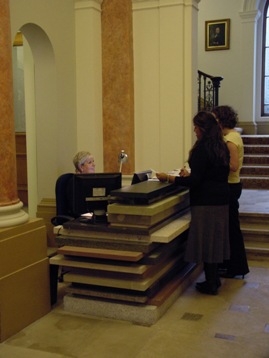
Geoscientist 17.5 May 2007
The new 1.7 tonne Reception Desk in the reinstated formal entrance from Piccadilly is a novel celebration of the Bicentenary - and much more besides, writes Eric Robinson*
Devised by the conservation architects Julian Harrap who have been slowly upgrading all the buildings around the Courtyard, including the Academy (the transparent lift to the Sackler Gallery), this monumental addition to the reinstated Piccadilly entrance definitely says “Rocks are us”.
Seventeen slabs of stone, roughly two metres long, were acquired and stacked to create the desk. There is no strict time ordering of the slabs, which may upset members of the Stratigraphy Commission; but the order was architect-devised and I suppose, must therefore be based on aesthetic criteria. One criticism must be that we see too little of each slab to be able to dwell upon textures, fossil content, or colour tone variation as we would like. But this is a Reception Desk with a job to do – though one of those jobs will, in due course, be to provide some geological instruction for visiting parties, especially school children.
Top of the pile comes green ‘slate’ from Broughton Moor, Cumbria, a classic Borrowdale Volcanic ash-ignimbrite. Its virtue, apart from the historic connection with the Burlington Family who own the quarry, lies in its solid and easy-clean surface. Below, it is the sad fate of Connemara Marble that its rich swirling patterns of this metamorphic limestone with its lustrous green tones, are lost to view under the overlap of the slab above.
Below the marble comes a pale green sandy limestone which is Chilmark Stone, glauconitic inland variant of the Portland Stone of the Dorset Coast, the stone of Salisbury Cathedral. Portland Stone itself stands out as a slab richly pock-marked by the hollow casts of fossils shells which we would recognise as the Roach variant of this, the best of UK building stones. It in turn largely hides a stone which we will recognise as the Purbeck ‘marble’ from the abundance of calcite-filled freshwater snails set in a dark and lustrous green matrix. We see only a few centimetres at either end, which is a pity because this is a stone with history.
In the summer of 2004, this ‘marble’ which is commercially difficult to obtain, was recovered through the acumen of ‘Trev’ Haysom – a third or fourth generation Purbeck quarryman with a wealth of local knowledge including the location of old workings. Old and abandoned workings tended to flood, many of the holes becoming orchards. When one was destined to become a caravan site, permission was given by the landowner for a rescue dig that produced several hundred tonnes of valuable stone from the three ribs of limestone that provide the ‘marble’. Two slabs of roughly dressed stone were found bearing tooled slots that would have allowed medieval quarrymen to have used lewis-like wedges to hoist the tonne-weight slabs on to carts for transport to the work sheds. The two-metre length of the desk was fashioned from this Purbeck bonanza.
The soft-toned red sandstone below is Triassic Hollinton sandstone from North Staffordshire, best known as the stone used by Basil Spence in the new Coventry Cathedral. Appropriately it was also the stone of the old Financial Times building in New Change and St Paul’s. By now we are about ankle-height, which makes it difficult to appreciate Black Kilkenny Limestone, cream-coloured Hopton Wood Stone beloved of Henry Moore and other sculptors, and two of our best sandstones from Peak Park and Leeds (Watt’s Cliff and Woodkirk). A sterner task still awaits petrologists wishing to examine Shap Granite, Corennie granite from mid-Aberdeenshire, or De Lank Granite from Bodmin Moor – the last bearing the responsibility of supporting the whole desk as foundation.
All seventeen chosen stones are classic British building stones which contribute to our built heritage and fortunately, remain available (if only just in some cases - English Heritage, please note!). For the Society’s celebration, it is of interest that all would have been in production in 1807 when the Society was born. How better could the Society celebrate its Bicentenary?
*Professor Eric Robinson has written two self-guided urban geology walks for the bicentenary. You can download notes and a map for these from the Society’s website. Visit the Bicentenary area of the site and click “Bicentennial London Walks” You can also join him for The White Cliffs of Dover Street (Thursday 17 May & Thursday 21 June 2007) and To Paradise by way of Kensal Green (Wednesday 16 May & Wednesday 20 June 2007). See website for details.
Geoscientist is offering publication as a prize to the most elegant structural solution explaining the reception desk’s stratigraphical confusions. Please send your solution to
[email protected]. The Editor’s decision shall be final, no correspondence will be entered into and no guarantees given.